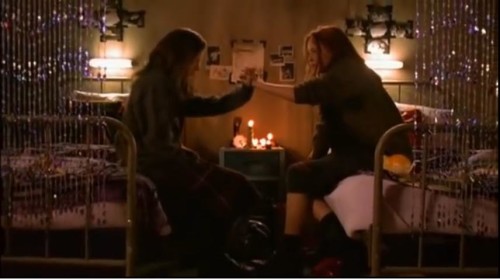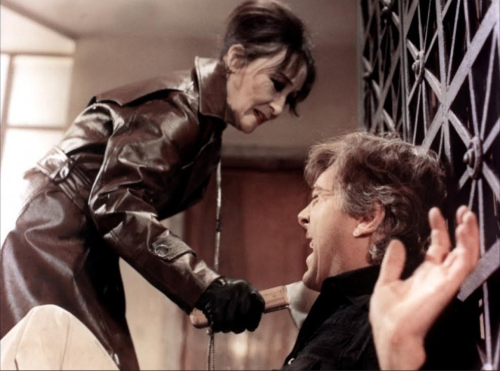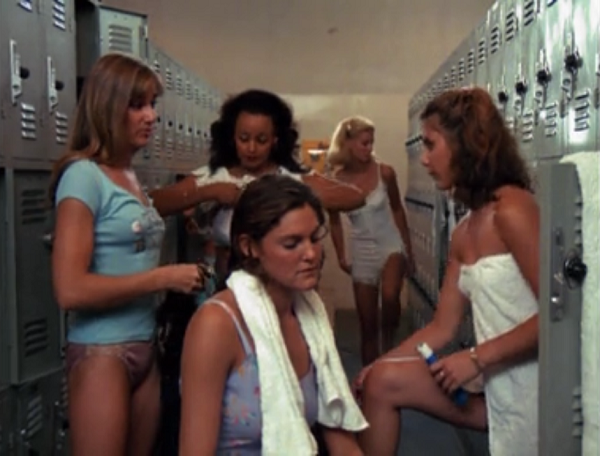This guest post by Kelly Piercy appears as part of our theme week on Violent Women.
Turn on any TV at primetime and you’ll likely see a sex worker dead in a dumpster. Or you’ll see a sex worker telling a cop all about that other sex worker who ended up dead in a dumpster. Because being aware and/or in control of your sexual identity can often be the most dangerous thing a woman in pop culture can be. Slasher films are overpopulated with hot young ripe things just ready to be plucked by a cartoonish serial killer. There will be jeering. There will be mutilation. Of this we can be sure. These things are sold to us on a regular basis.
What we can’t be so sure of however, is what fresh hell each teenage girl experiences with their hormones on an individual basis. Or what really happens when you get bitten by a werewolf. There will be blood in both instances, yes. But there will be a whole host of weird surprises. In Ginger Snaps, those two things just so happen to combine in one film, and you’ll soon become endlessly irritated that you didn’t think of it yourself. It is one of body horror’s great allegories. And there is so much room for snark. With Ginger Snaps, we have one of the most interesting examinations of violence in this bleak world that is representation in film. Certainly the only one where the teenage girl does the mutilating. And truth be told, it’s hard not to feel completely exhilarated by it. Even when you’re heaving.
Describing Ginger Snaps in a sentence might sound something like “an excellent example of subversion of genre norms coupled with language that belongs in the pop culture hall of fame.” Something that would also work is “two teenage girls being fucking awesome.” Because in Ginger Snaps, teenage girls are smarmy and moody – of course they are – but also passionate and resourceful. The dialogue is funny and brimming with wicked imagery as opposed to sleeping through clunky exposition and gender conformity. Horror films have a history of violent transformation or destructive host and the repercussions of these changes in public spaces, but not many examine the female body specifically and it’s place in society, the specific “monstrous feminine.” The genre path of teenage sexual behaviour leading to monstrosity strangely never stopped to think about periods. Ginger Snaps takes a long hard look at “the curse” and plays with both its stereotypes and its biological facts incredibly honestly.
Ginger, despite morphing into a werewolf, becomes our protagonist killer in a very human way, and the complexity of her journey is a cinematic rarity. A large part of its appeal is the addictive excitement-and-relief cocktail that comes with seeing your experiences reflected on screen–to see menstruation from a menstruating perspective. Who wouldn’t see want to see the violence of their PMS daydreams being played out? Ginger Snaps gives its characters a small town and a big world, and the result for its viewers reflects as both deeply personal and pure escapism. Also known as the ingredients for the perfect horror. Get ready to fall in love with the Fitzgerald sisters.
How early does the violence start in Ginger Snaps? A more appropriate question might be “How many films can you recall opening with the massacred corpse of a family dog?” Marley and Me, this isn’t. There’s a wild animal killing the canine population of the sleepy town of Bailey Downs, and nobody really seems too concerned. But we don’t have time to dwell because soon we’re met with the sight of 15-year-old Brigitte, both slouchy and creepy, emerging from her garage, hooked up with tools. Like Dick Van Dyke with all his instruments in Mary Poppins, but a teenage girl with wires and shit. I’m not going to get into Emily Perkins’ physicality in this film because the level of scowl perfection alone is truly inspiring, and it deserves an article in its own right. Suffice to say, this is when I knew I was with Ginger Snaps for the long haul.
As well as Brigitte, we also get the privilege of Ginger, who is the older, edgier, decidedly more daring sibling partner in crime. Ginger and Brigitte muse on suburban mundanity in their shared basement bedroom, while Ginger traces her arm with a knife: “Wrists are for girls, I’m slitting my throat,” she scoffs. We move to Ginger impaled on their garden fence, ruptured at the abdomen, limbs splayed, blood everywhere. Then Brigitte leans in and takes a photograph. Yes. These little shits are staging various death poses for a school project! It is so glorious I smile immediately, wickedly even. I feel pure joy radiate out. This is my comfort zone. And so our titles roll and with them comes dozens of DIY photos of Brigitte and Ginger, meeting variously creative gruesome ends. They’re showing this as a slideshow to their classmates, for a school project. It drips with bad taste. Their teacher can’t believe it. I told you you’d love the Fitzgerald sisters.
It’s not long before the fake blood is replaced with real blood. Sixteen-year-old Ginger’s first period and her transition into a werewolf happen simultaneously. What a day, huh? Society punishes women for being women, this is another one of those things we can be sure of. In this particular instance, Ginger is punished for becoming a woman by being violently savaged by a wild beast, which doesn’t sound too different from the online comments section. In a lot of ways Ginger Snaps seems even more relatable in today’s climate than in 2000, the year of its release.
Ginger’s own metamorphosis masquerades as regular, as mundane. Adult women assure her of her normality. But one transformation is obscuring the other, as highlighted by the excellent scene with the school nurse that hits every parallel beat with precision. Menstruation is the birth of Ginger as a threat. Hurtling toward womanhood, she is now decidedly different than a male, she is now the monster that lies within the feminine, and more accurately the feminine that intimidates the masculine. The unattainable, confusing and unfathomable, the unknown onto which the fear is projected. Oh, and she’s also physically becoming a gnarling brute that really wants to rip human flesh to shreds. So there’s that.
But at first Ginger doesn’t recognise her yearning for splattered organs, she just thinks she needs to get laid. Pre-menstrual, Ginger is vaguely disinterested in boys at best. When the schools resident Bro Boy first makes a move she is almost puzzled, and a simple “Er, no…” will suffice as she continues walking, a fly swatted. Later, when he tells her about his sisters and insists that when it comes to cramps “nothing takes the edge off like a toke,” she replies simply again, “Maybe I like my edge, thanks.” The way that Katherine Alexander’s delivery complements the dialogue is unmistakeable in many of Ginger’s best lines. Her attitude could be reactionary, bratty, and dramatic, but instead it is deliciously restrained. This brings with it an awareness of the shouty, quick tempered, usually improv-based insult scenes prevalent in films currently–the “say the grossest thing you can as loud as you can” approach. Getting increasingly shouty in a very short space of time seems to be the default in a lot of comedies (looking at you, America) and Ginger Snaps felt like a reminder. Shouty is funny when it’s the rarity. And a lot of comedies could benefit from Ginger Snaps’ example of less is more. They could also benefit from Mimi Rogers’ more is more, perfectly cast as the girls’ excessively perky mother. The implication being that Ginger Snaps is not only a superior horror film, but a superior comedy as well.
But back to Ginger. Her sexual ambivalence is marked by a classic slow motion strut-slash-glide through the school hallway. She is now Sexually Awakened™ and interested in Bro Boy. After getting rough with him in the back of his car, Brigitte finds her in their bathroom. “I get this ache,” Ginger says, head in the toilet, hair silver and covered in blood, “I thought it was for sex, but it’s to tear everything to fucking pieces.” She just lost her virginity, and it could have essentially been soundtracked by Duran Duran’s “Hungry Like The Wolf.” So she killed a dog after.
Ginger’s acts of violence are now accelerating, with her temper becoming increasingly explosive. Both the hockey field and the neighbour’s garden offer chances for instant relief, but it’s not enough. Ginger’s hunger is all-consuming. Hormones multiplied by a taste for blood equals death and infection. Brigitte’s got a real problem on her hands trying to fix this. As she panics, racing to find a cure to save her sister, Ginger remains devilishly nonchalant. She justifies her actions simply: “No one ever thinks chicks do shit like this. A girl can only be a slut, a bitch, a tease, or the virgin next door. We’ll just coast on how the world works.” You can’t fault her insight. But Brigitte is in a dangerous situation now, facing off with GingerWolf, so it sounds like it’s about time for a knight in shining armour to draw a sword and fight the Big Bad, doesn’t it? Nope, Ginger Snaps still doesn’t let you down, because when Brigitte’s drug dealer sidekick Sam (think Canadian Jason Dean) suggests taking the cure and fleeing the monster, Brigitte shouts “HOW ABOUT NO!” in his face. The sisters have a pact, “out by 16 or dead on the scene, but together forever.” In the end, we know that Brigitte has to figure this out alone.
Throughout their lives, the Fitzgerald sisters operated exclusively as a unit. Ginger can be bolder, domineering and baiting, and Brigitte grounds her, more prone to analysing and logistics. There is a repetition of the mantra “this is so us” coursing through – if Ginger leaves the dinner table, Brigitte follows, if Ginger offers up a judgement, Brigitte extends it. They have matching bone pens. They are functioning as one, in spite of an obviously unbalanced power dynamic and personality difference, and they are both aware of this, becoming increasingly vocal about it as the film progresses. When Ginger’s acts of violence become more heinous, the distinctions between the two of them mobilise and the separation gains speed. As Ginger becomes a killer, Brigitte becomes an individual. Brigitte forces her own journey to Werewolfdom by actively sharing blood with Ginger, and she proceeds with complete self-awareness, in control of her body and the changes she knows are coming. She goes into the fight equipped not only with the experience of witnessing Ginger’s destruction, but with the necessities to survive womanhood: a strong sense of self, the courage to call out bullshit, and a fierce possessiveness of your own body.
Despite always wanting to be a screenwriter, I have never wanted to write horror. Now I do. This is representation in action, folks! I am living proof of it! Power to the Ontario Gothic. This is how it’s done.
Kelly Piercy is a Lit grad and comedy writer based in London. She mostly enjoys Leslie Knope, Sleater Kinney, and Cher’s twitter feed.



















